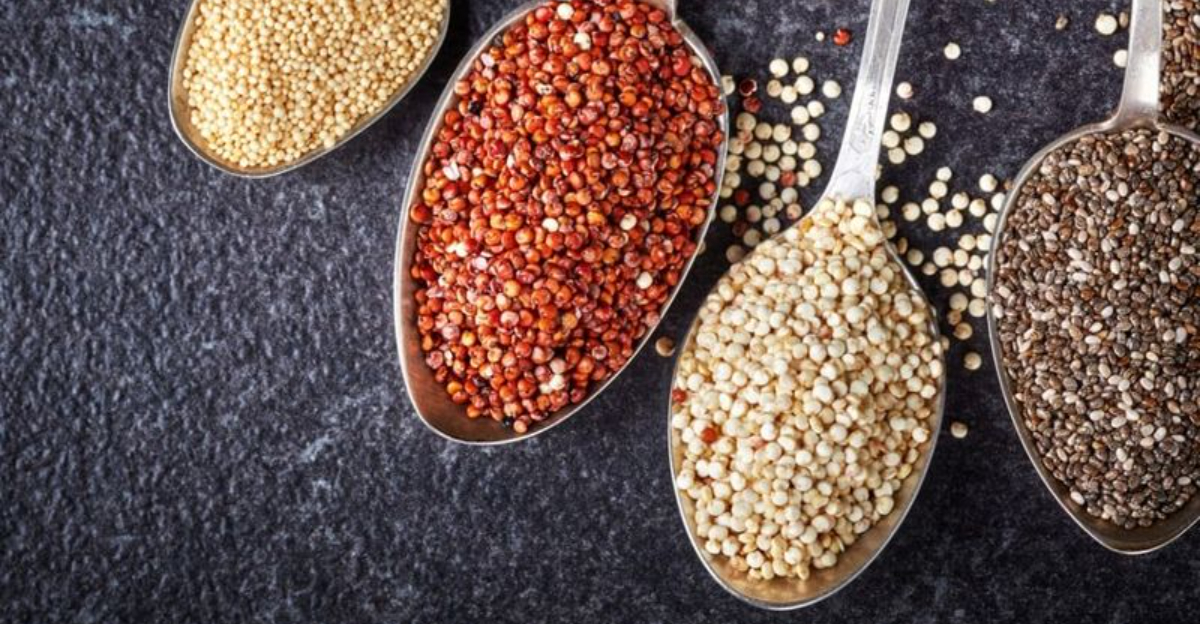20 Food Names Many People Pronounce Wrong

Ever been at a fancy restaurant and stumbled over a menu item, only to have the waiter correct you with a slight smirk? We’ve all been there.
Food names from around the world can be tricky to pronounce, especially when they come from languages with different sounds than English.
Let’s clear up some common food pronunciation mistakes so you can order with confidence next time.
1. Bruschetta: Skip the ‘SH’ Sound
Americans love to say ‘broo-SHET-ah,’ but Italians would wince at this pronunciation. The authentic Italian way is ‘broo-SKET-ah’ with a hard ‘k’ sound instead of the ‘sh.’
This appetizer of toasted bread with toppings deserves proper respect. The name comes from the Italian verb ‘bruscare,’ meaning ‘to roast over coals,’ referring to the traditional preparation method of the bread base.
2. Quinoa: Not ‘Kwin-OH-ah’
This South American grain has tripped up countless health food enthusiasts. The correct pronunciation is ‘KEEN-wah,’ not the commonly heard ‘kwin-OH-ah.’
The grain comes from the Andean region where it was a staple for indigenous peoples for thousands of years. Next time you’re at the organic section of your grocery store, you can confidently ask for this protein-packed pseudocereal by its proper name.
3. Acai: Three Syllables, Not Two
This superfood berry from the Amazon isn’t pronounced ‘ah-SIGH’ as many say. The correct way is ‘ah-sah-EE,’ giving proper emphasis to all three syllables.
I remember my first time ordering an acai bowl at a juice bar. The employee gently corrected my pronunciation, and I’ve never forgotten it since.
The purple berry has skyrocketed in popularity for its antioxidant properties and refreshing taste in smoothie bowls.
4. Gyro: Not ‘JY-row’
This delicious Greek sandwich isn’t pronounced like a gyroscope. The correct Greek pronunciation is closer to ‘YEE-ro’ or ‘YEAR-o,’ with a slight rolling of the ‘r.’
The name references the vertical rotisserie the meat cooks on, which turns in circles (like a gyration). Many Americans continue to say ‘JY-row,’ but now you know the authentic pronunciation that would make any Greek grandmother proud.
5. Pho: Not ‘FOH’
This Vietnamese soup has gained worldwide popularity, but many still mispronounce it. It’s not ‘FOH’ but rather ‘FUH’ (like ‘duh’ with an ‘f’).
The clear broth noodle soup typically contains beef or chicken and is served with herbs and bean sprouts.
Vietnamese cuisine experts note that the name is actually thought to have French origins, possibly from ‘pot-au-feu,’ a French beef stew, reflecting Vietnam’s colonial history.
6. Gnocchi: The ‘G’ is Silent
These Italian potato dumplings aren’t pronounced ‘guh-NO-chee’ or ‘guh-NO-kee.’ The correct Italian pronunciation is ‘NYOH-kee,’ where the ‘gn’ creates a sound similar to the ‘ñ’ in Spanish.
The word may come from ‘nocchio,’ meaning a knot in wood, or from ‘nocca,’ meaning knuckle. Both references make sense given the small, knuckle-shaped appearance of these pillowy potato delights that have been part of Italian cuisine for centuries.
7. Croissant: Skip the Hard ‘T’
The French would cringe at ‘KWAH-sant’ with a pronounced ‘t’ at the end. The authentic French pronunciation is ‘kwah-SAWN,’ where the final ‘t’ is silent.
I still remember my first trip to Paris, where the bakery clerk gently shook her head at my American pronunciation. These buttery, flaky pastries actually originated in Austria as the ‘kipferl’ before being adapted by French bakers.
The crescent shape was supposedly inspired by the Ottoman Empire’s flag.
8. Espresso: There’s No ‘X’
Coffee lovers take note: it’s not ‘EX-presso.’ The correct pronunciation is ‘es-PRESS-oh.’ There’s no ‘x’ in the spelling, so there shouldn’t be one in the pronunciation either.
The name comes from the Italian word meaning ‘expressed’ or ‘forced out,’ referring to the method of forcing hot water through finely-ground coffee beans.
This concentrated coffee preparation forms the base of many beloved coffee drinks from lattes to cappuccinos.
9. Prosciutto: It’s ‘Pro-SHOOT-oh’
This Italian dry-cured ham isn’t ‘pro-SKEW-toe’ or ‘pro-SHOO-toe.’ The correct Italian pronunciation is ‘pro-SHOOT-oh,’ with emphasis on the middle syllable.
I once embarrassed myself at an Italian deli counter by mangling this word until an elderly Italian man kindly corrected me.
This delicacy is made from a pig’s hind leg or thigh, salt-cured and air-dried for months or even years, resulting in its distinctive sweet flavor and tender texture.
10. Foie Gras: Not ‘Foy Grass’
This controversial French delicacy isn’t pronounced ‘foy grass.’ The correct French pronunciation is ‘fwah grah,’ with a soft ‘r’ sound in the second word.
The term literally translates to ‘fat liver’ in French, describing this rich spread made from duck or goose liver.
While its production methods remain contentious, its buttery texture and complex flavor have made it a luxury food item in French cuisine for centuries.
11. Turmeric: Not ‘TOO-meric’
This golden spice isn’t ‘TOO-meric’ but ‘TUR-mer-ik,’ with the first ‘r’ clearly pronounced. Many English speakers drop this first ‘r’ sound entirely.
The vibrant yellow powder comes from the root of a plant related to ginger. Growing up in a household that used turmeric daily, I’ve heard countless mispronunciations at grocery stores.
This ancient spice has been used in cooking and medicine for thousands of years across South Asia.
12. Tzatziki: The ‘T’ is Not Silent
This Greek yogurt sauce isn’t ‘zah-ZEE-kee.’ The correct pronunciation includes the initial ‘t’ sound: ‘tsah-TZEE-kee,’ though it blends with the ‘z’ in a way that’s tricky for English speakers.
Made with yogurt, cucumber, garlic, and herbs, this refreshing sauce accompanies many Greek dishes. The word itself likely comes from the Turkish ‘cacık,’ showing how food traditions cross borders.
Many Mediterranean cultures have their own version of this cooling yogurt-based condiment.
13. Bouillabaisse: Not ‘Bully-Base’
This French seafood stew from Marseille isn’t ‘bully-base.’ The correct French pronunciation is closer to ‘boo-yuh-BESS,’ with the ‘ll’ creating a ‘y’ sound.
Traditional bouillabaisse contains at least three types of fish and various shellfish. I’ll never forget watching a French chef wince when a customer loudly ordered ‘BULLY-base’ at his restaurant.
The name comes from two cooking methods: ‘bouillir’ (to boil) and ‘abaisser’ (to reduce).
14. Mascarpone: Four Syllables, Not Three
This Italian cream cheese isn’t ‘MASK-ar-pone.’ The correct Italian pronunciation is ‘mas-kar-POH-nay,’ with four distinct syllables and emphasis on the third.
Used in tiramisu and other Italian desserts, this rich, buttery cheese adds incredible creaminess. My Italian grandmother would correct anyone who mispronounced it, insisting that proper pronunciation showed respect for the food.
The cheese originated in the Lombardy region of Italy between the 16th and 17th centuries.
15. Chipotle: Not ‘Chi-POLE-tay’
This smoked jalapeño pepper isn’t ‘chi-POLE-tay’ as many say. The correct pronunciation from its Mexican origin is ‘chi-POHT-lay,’ with the ‘tl’ forming a specific sound that’s challenging for many English speakers.
The word comes from the Nahuatl language, combining ‘chilli’ (chile pepper) and ‘poctli’ (smoke). These peppers are actually just ripened, smoked jalapeños, not a separate pepper variety.
They bring a distinctive smoky heat to many Mexican and Tex-Mex dishes.
16. Edamame: Four Syllables of Goodness
These young soybeans aren’t ‘ed-uh-MOM-ay.’ The correct Japanese pronunciation is ‘eh-dah-MAH-meh,’ with equal emphasis on all four syllables.
The name literally means ‘stem beans’ in Japanese, as they were traditionally sold still attached to the branch. I remember being corrected by a sushi chef when ordering these as an appetizer.
These nutritious beans are typically boiled or steamed and served with salt as a protein-rich snack.
17. Niçoise: Not ‘Ni-KOISE’
This French salad isn’t ‘ni-KOISE’ or ‘ni-KOYZ.’ The correct French pronunciation is ‘nee-SWAHZ,’ with the ‘ç’ making an ‘s’ sound.
Named after the city of Nice in the south of France, this composed salad traditionally includes tuna, hard-boiled eggs, olives, and vegetables.
The cedilla under the ‘c’ (ç) changes the pronunciation from a hard ‘k’ sound to a soft ‘s’ sound, following French pronunciation rules.
18. Charcuterie: Not ‘Char-CUT-er-ee’
This trendy meat and cheese board isn’t ‘char-CUT-er-ee.’ The correct French pronunciation is ‘shar-koo-tuh-REE,’ with emphasis on the final syllable.
The term comes from French words meaning ‘flesh’ and ‘cooked,’ originally referring specifically to prepared meat products like pâtés and terrines.
My first attempt to order one at a French bistro resulted in blank stares until a friend whispered the correct pronunciation.
Today’s Instagram-worthy boards typically include various cured meats, cheeses, fruits, and crackers.
19. Parmigiano-Reggiano: Not ‘Parmesan Reggiano’
This isn’t just fancy ‘parmesan.’ The correct Italian pronunciation is ‘par-mee-JAH-noh red-JAH-noh,’ with proper emphasis on the third syllable of each word.
This king of cheeses must be produced in specific provinces of Italy under strict regulations to bear this name. I once visited a cheese aging facility in Parma, where the producer winced every time tourists said ‘PAR-muh-zan.’
The hard, granular cheese is aged at least 12 months, with some varieties aged up to 36 months.
20. Quesadilla: The Double ‘L’ Changes Everything
This Mexican favorite isn’t ‘kay-suh-DIL-uh’ with an ‘L’ sound. In Spanish, the double ‘l’ creates a ‘y’ sound, making it ‘kay-suh-DEE-yah.’
The name combines ‘queso’ (cheese) and ‘tortilla,’ literally meaning ‘little cheesy thing.’ Regional Mexican variations may include different fillings beyond cheese.
This simple but delicious dish dates back to the 16th century in central and northern parts of Mexico.
